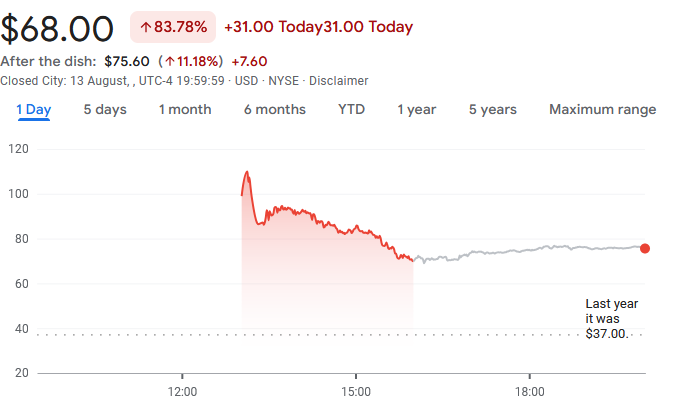[US IPO] "Crypto's New Darling": Bullish Rockets 200% in Wild Trading Debut

TradingKey - The New York Stock Exchange welcomed a major cryptocurrency sector listing on August 13 with the debut of crypto exchange Bullish (ticker: BLSH). Shares surged dramatically on opening day, hitting an intraday high of $118 per share—more than 200% above its $37 IPO price.
Bullish opened at $102 per share before experiencing volatility, closing at $68—a gain of 83.78% from its offering price. This closing valuation placed Bullish’s market capitalization at $9.94 billion, approaching the $10 billion threshold.
In after-hours trading, shares rose 11.18% to $75.60, pushing market capitalization above $10 billion.

Source: Google Finance
Bullish became the second crypto exchange to list on NYSE following Coinbase. Notably, to meet strong investor demand, Bulllish priced its IPO at $37 per share on Tuesday—significantly above the previously targeted $28–31 range.
The offering received over 20x oversubscription, yielding an initial valuation of approximately $5.4 billion at the offering price. "Bullish came out with an attractive initial valuation, and investors responded by aggressively bidding it up during the pre-IPO process," noted Jeff Zell, Senior Research Analyst at IPO Boutique.
Bullish President Chris Tyrer stated, "We've gone public today, and there's a slew of others that are going to follow us, and I think that is net beneficial, because it gives people more options in terms of how they access this asset class."
Bullish’s listing marks it as the first cryptocurrency company to go public following President Trump’s signing of the Guidance and Establishment of American Stablecoin National Innovation Act.
Tyrer added: "Public capital markets are demonstrating clear interest in investing in crypto companies." Bullish’s IPO coincided with Bitcoin recently hitting all-time highs.
However, the stock’s extreme volatility and significant premium over the IPO price reignited debates about pricing fairness. Notable venture capitalist Bill Gurley and others criticized underwriters for pricing similar IPOs too conservatively, arguing that billions of dollars in potential proceeds flowed to day-one traders rather than the issuing company.







